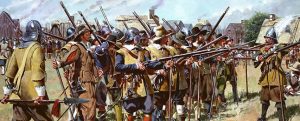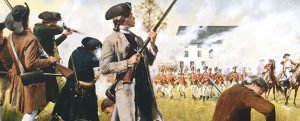The Massachusetts Army National Guard is proud to have the four oldest organizations in the U.S. Army or the Army National Guard serving within its ranks.
The 101st Engineer Battalion, the 101st Field Artillery Regiment, the 181st Infantry Regiment, and the 182nd Infantry Regiment trace their lineage to the North, South and East Regiments which were formed by legislative act of the Massachusetts Bay General Court on December 13, 1636. This date is recognized as the birthday of the National Guard.
The regiments were designated by geographic part of the colony: the North Regiment, from which the 181st Infantry and 182nd Infantry are descended, consisted of companies in the North and West including Charlestown, Cambridge, Watertown, Medford and Concord; the South Regiment, known today as the 101st Field Artillery, consisted of companies in Boston, Dorchester, Roxbury, Weymouth and Hingham; and finally, the East Regiment, forbearer of the 101st Engineer Battalion, consisted of companies in the Northeast from Salem, Saugus, Ipswich, and Newbury.
The 101st Engineers, 181st Infantry and the 182nd Infantry Regiment are the only units in the U.S. Army who can display the Lexington-Concord battle streamer since units they are descended from fought battles in Lexington, Concord and Arlington on April 19, 1775 at the opening of the Revolutionary War.
These four organizations, which have served the commonwealth and the nation for more than 375 years and have participated in nearly every American war from 1775 to the present, are proud to be the Nation’s First!

Salem, Massachusetts, 1637
The history of the National Guard began on December 13, 1636, when the General Court of the Massachusetts Bay Colony ordered the organization of the colony’s militia companies into three regiments: the North, South and East Regiments. The colonists had adopted the English militia system which obligated all males, between the ages of 16 and 60, to possess arms and participate in the defense of the community. The early colonial militia drilled once a week and provided guard details each evening to sound the alarm in case of attack. The growing threat of the Pequot Indians to the Massachusetts Bay Colony required that the militia be in a high state of readiness. The organization of the North, South and East Regiments increased the efficiency and responsiveness of the militia. Although the exact date is not known, the first muster of the East Regiment took place in Salem, Massachusetts. The National Guard continues its historic mission of providing units for the first-line defense of the nation. The 101st Engineer Battalion, Massachusetts Army National Guard, continues the East Regiment’s proud heritage of 350 years of service.

Lexington, Massachusetts, April 19, 1775
In the early hours of April 19, 1775, Captain John Parker was alerted to mobilize the Lexington Company of the Middlesex, County Brigade, Massachusetts Militia in anticipation of a British 700 man force which was marching to Concord to capture provincial arms. By 2 a.m. Parker had mustered his company on the Lexington Green. The Lexington Company of militia was typical of the period. The youngest militiaman was 18, the oldest 63; eight fathers and sons served together. Most were farmers while some were veterans of the French and Indian War. Just after sunrise Parker and his 77 militiamen stood in defiance of the British advance guard. “Stand your ground,” Parker ordered. “Don’t fire until fired upon. But if they want to have a war let it begin here.” Major John Pitcairn, commander of the British advance guard, ordered the militiamen to lay down their arms. Realizing that his company was outnumbered, Parker ordered his men to disperse. As the militiamen began to break ranks, a British officer fired his pistol. Without orders, the British troops opened fire. Although greatly outnumbered, the militiamen returned the fire. The battle went on for several minutes all around the Green. When it was over eight Americans lay dead and nine were wounded. The British quickly resumed their march. Later that morning, Captain Parker reorganized his unit and marched to Concord. The Lexington Company would later fight in the Battle of Bunker Hill and form a company for service in the Continental Army. However, few of its members on that fateful April morning realized that the Battle of Lexington would lead to the Revolutionary War and American independence. The Lexington Company and the Middlesex County Brigade are perpetuated by the 181st and 182nd Infantry Regiments, Massachusetts Army National Guard.

